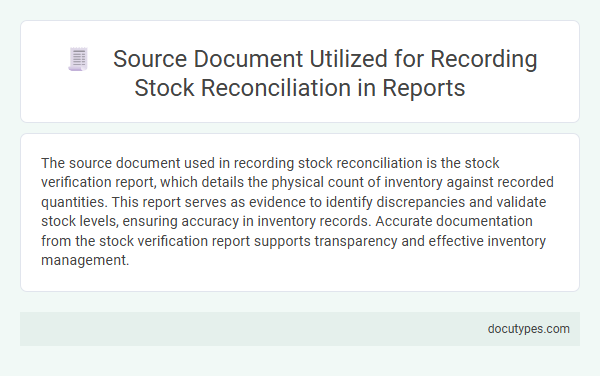The source document used in recording stock reconciliation is the stock verification report, which details the physical count of inventory against recorded quantities. This report serves as evidence to identify discrepancies and validate stock levels, ensuring accuracy in inventory records. Accurate documentation from the stock verification report supports transparency and effective inventory management.
Introduction to Source Documents in Stock Reconciliation
Source documents play a crucial role in the stock reconciliation process by providing the primary evidence needed for accurate inventory records. These documents include purchase invoices, delivery notes, stock transfer forms, and stock count sheets that reflect actual stock movement and adjustments. Utilizing these records ensures that stock levels are verified systematically, minimizing discrepancies between physical inventory and accounting data.
Definition and Importance of Stock Reconciliation
Stock reconciliation is the process of verifying the physical inventory against the recorded stock data to ensure accuracy and prevent discrepancies. It helps maintain accurate inventory records critical for effective inventory management and financial reporting.
The primary source document used in recording stock reconciliation is the stock count sheet, which details the quantities of items counted during a physical inventory check. This document serves as the official record for comparing actual stock against system records, facilitating adjustments where necessary.
Key Source Documents Used for Stock Reconciliation
Stock reconciliation requires accurate source documents to verify inventory records and ensure consistency between physical count and accounting records. Key source documents provide essential data for identifying discrepancies and maintaining accurate stock levels.
- Physical Stock Count Sheets - These documents record the actual quantity of inventory items counted during stocktaking.
- Goods Receipt Notes (GRNs) - GRNs document the receipt of stock into inventory, offering proof of goods delivered by suppliers.
- Delivery Challans - Delivery challans serve as evidence of stock dispatched from the warehouse or supplier, crucial for tracking stock movement.
Role of Invoices in Stock Reporting
Source documents play a crucial role in accurately recording stock reconciliation, ensuring inventory records match physical stock counts. Among these documents, invoices are essential for verifying the receipt and dispatch of goods during stock reporting.
- Invoices confirm transactions - They provide detailed records of purchases and sales, supporting accurate stock adjustments.
- Invoices validate stock changes - Each invoice corresponds to a specific stock movement, aiding in error detection.
- Invoices support audit trails - They create a verifiable link between inventory records and financial accounting.
Invoices serve as a foundational source document in stock reconciliation, enabling precise and transparent inventory management.
Utilizing Goods Received Notes (GRNs) for Reconciliation
Stock reconciliation requires accurate source documents to verify inventory levels. Goods Received Notes (GRNs) serve as critical records for confirming the receipt of stock items from suppliers.
Utilizing GRNs in stock reconciliation ensures that physical inventory matches recorded entries. These documents provide detailed information such as quantities, descriptions, and delivery dates, streamlining the verification process.
Importance of Delivery Challans in Stock Records
| Source Document | Delivery Challan |
|---|---|
| Purpose | Used for recording stock reconciliation to verify physical inventory against stock records. |
| Importance in Stock Records | Delivery Challans provide detailed information about the items delivered, including quantities, descriptions, and dates, ensuring accurate stock updates. |
| Role in Stock Reconciliation | Act as primary evidence for stock movements, helping to identify discrepancies between recorded and actual stock levels. |
| Benefits for Your Business | Maintaining delivery challans improves inventory accuracy, reduces errors, and streamlines auditing processes. |
Stock Adjustment Vouchers as Supporting Evidence
What source document is used in recording stock reconciliation?
Stock adjustment vouchers serve as the primary source document in recording stock reconciliation. These vouchers provide detailed evidence of changes in inventory levels, ensuring accurate stock records.
Significance of Physical Stock Count Sheets
Source documents used in recording stock reconciliation primarily include physical stock count sheets, which serve as tangible evidence of inventory levels at a specific point in time. These sheets play a critical role in verifying the accuracy of stock records, helping to identify discrepancies caused by theft, damage, or administrative errors. Maintaining detailed and accurate physical stock count sheets ensures reliable data for financial reporting and inventory management decisions.
Audit Trail and Compliance Considerations
Source documents used in recording stock reconciliation primarily include inventory count sheets and stock movement records. These documents form the basis for verifying physical stock against accounting records.
Maintaining a clear audit trail is essential for ensuring accuracy and accountability in stock reconciliation. Source documents provide evidence to support recorded transactions, facilitating compliance with regulatory standards. Proper documentation helps auditors trace discrepancies and verify inventory valuations, enhancing overall financial integrity.
What Source Document Is Used in Recording Stock Reconciliation? Infographic

